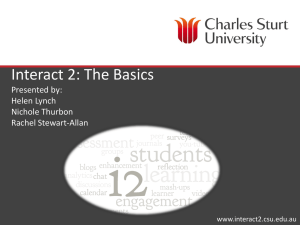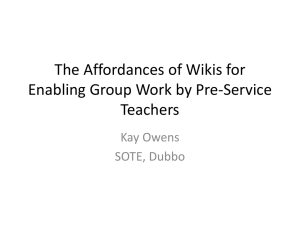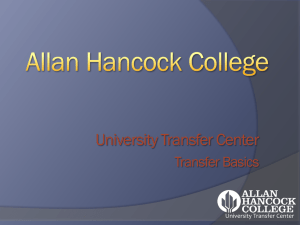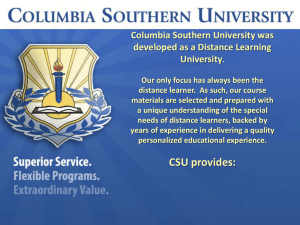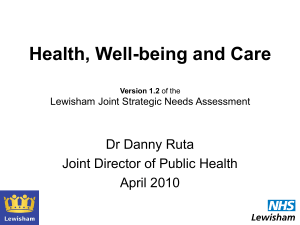Agenda Item 5 - Lewisham Strategic Partnership
advertisement
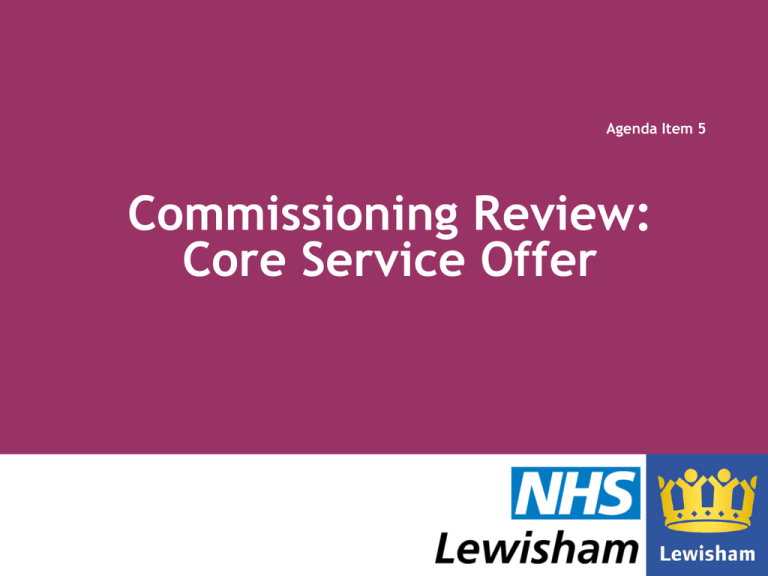
Agenda Item 5 Commissioning Review: Core Service Offer 1 Objectives • To review core service offer across universal, targeted and specialist tiers • To improve outcomes • To identify efficiencies and cost reductions • To pursue total place thinking • To seek opportunities available through partnership working 2 Principles • Pragmatic and time-limited • Needs focused and whole system thinking • Green-field approach • Challenging – back to basics • Searching for minimum offer – to be supplemented with service add-ons where budgets allow or political priorities require 3 Radical efficiencies • Different, better, cheaper • Radical efficiency turns the role of provider on its head – no longer solution ‘deliverers’, but pioneers of a new type of public service, asking difficult questions about who they are trying to serve and what they are trying to achieve • Services will look different in different areas • Radically efficient systemic reform moves from being desirable to being purposeful, pragmatic and urgent • Embedding radical efficiency at the heart of a new approach to public services would require a fundamental reshaping of accountability frameworks, funding sources and allocations; understanding of risk and of shared values • Better together – for radical efficiency to be possible, integration has to be a habit and an instinct, not a behaviour forced into being by financial reward or legislation The Innovation Unit 2009 Approach Project Scoping Needs Analysis Service Analysis Policy Review JCG Workshop JSNA Review SUM Interviews Develop Approach KPI Analysis Workforce requirements Project Initiation Service Specs Questionnaires Policy review to identify statutory requirements Service Mapping VFM and Impact Identification of core functions 3 Projects Needs confirmed As Is Picture Options + Costings Conclusions Configuration to core functions Universal Under 5, Early Intervention and Complex Scope for integration DMT review Resources: Reshape, Recycle or Released Proposed Future Model Political consideration Decisions on selected transformation Agreed scope Service Transformation 5 Needs analysis conclusions • Research from JSNA, services specifications, KPIs • Confirms current needs analysis still appropriate to inform service planning • Suggests further scope to strengthen the impact of services – particularly at the targeted tier • Needs analysis has been used to underpin the review of the core offer 6 Proposed Strategic Direction Push Down Step 2: Over next 12-36 months meet some complex needs earlier Step 3: Reshape early intervention services on an invest to save basis, reducing costs where possible Step 4: Achieve Further Savings Improve Outcomes Locality Model Multi-Agency Teams Pull Up Step 1: Over next 12 months redirect efficiencies from universal tier i.e. A Whole System Approach 7 Conclusions: Universal Services Universal Under 5 Proposal Vision • Within 12 months an integrated partnership service will provide a core programme of advice, assessments, and development interventions for all pregnant women, children under the age of 5 and their families in Lewisham, reducing costs and improving the efficiency and effectiveness of local services. Objectives of Project Scoping • To define the core universal under 5 service offer and service model for its delivery • To reduce costs of service provision • To improve outcomes • To achieve significant savings across the CYP partnership 9 ‘As is’ mapped against ‘To be’ Services by Tier: ‘As is’ Services by Tier: Universal UNIVERSAL LOCAL AUTHORITY (GEN FUND) LA/PCT (GEN FUND & GRANT) Standards & Achievement: Strategic Secondary Access & Support: IYSS (Youth Service Areas, Borough-Wide Project and Programme and Activity) Access & Support: IYSS (Young People's Participation Project) Standards & Achievement: Strategic early years Access & Support: IYSS (IAG) Standards & Achievement: Governor services Standards & Achievement: Business & Governor Services Access & Support: IYSS (Adventure Playgrounds) Standards & Achievement: Strategic Primary HEALTH PCT CHS: Health Visiting PCT CHS: School Age Nursing PCT CHS: SRH services (Adults) PCT: Newborn Hearing Screening Programme (Southwark Provider) Access & Support: IYSS (Summer Holiday Activities) PCT: Vision Screening (Kings College Hospital) Access & Support: Educational Access (Admissions) Education & Development: Strategic ICT UHL: Midwifery Service Mayor's Office: Young Mayor & Advisors Education & Development: 14-19 PCT: GPs Mayor's Office: Young Citizens Panel Education & Development: Pupil Places Education & Development: BSF school engagement Education & Development: PCP Programme Education & Development: Healthy Schools Programme? GRANT Under 5's + provision Children's Centres, Childcare & Play (Sure Start Grant) 5 Steps Community Nursery (CSU funded) Ackroyd Children and Family (CSU funded) Acorn Children's Club (CSU funded) Bunbury Childminders Project (CSU funded) Lewisham Toy Library (CSU funded) Playhouse Community Nursery (CSU funded) St Andrews Community Nursery (CSU funded) Lewisham Opportunities Pre-School (CSU funded) Lewisham Playbus (CSU funded) Youth provision 2nd Deptford Scouts (CSU funded) Forest Hill Youth Project/ Platform 1 (CSU funded) PSLA - Lewisham Branch (CSU funded) Wesley Hall Youth Committee (CSU funded) Young Lewisham Project (CSU funded) Youth Aid Lewisham (CSU funded) Lewisham Manor Scouts (CSU funded) Lewisham Young Women's Resource Project (CSU funded) Limelight Family Learning Centre (CSU funded) Marvels Lane Boys Club (CSU funded) Access & Support: IYSS (TP Prevention) Play areas Somerville Adventure Playground (CSU funded) Education Supplementary Schools x 17 (Funded through LCF) Other Extended services Conclusions: 1 • The majority of universal services for the Under 5s are health related and determined by the key elements of the CHPP, with the main exception being the early years foundation stage (i.e. free entitlement to 3 and 4 yr olds). • These requirements are likely to continue and are consistent with indicative Coalition policy. • This presents an opportunity to stop children’s centre universal offer and re-invest into targeted services (e.g. newly configured Early Intervention Service) / or continue targeted provision within 30% most deprived areas. 11 Conclusions: 2 • Need to review the minimum role of LA i.e. in regulating PVI nursery sector, academy schools and in the provision of information to children and families • Further opportunities exist to review the universal youth offer, and reapply similar strategic principles. For example refocusing service to targeted provision within 30% most deprived areas – potential to income generate or leave to the 3rd sector • Need to challenge some strategic programmes i.e. NCMP, Healthy Schools Programme, TP Prevention, SRE commissioned through Health, Public Health programmes – should we reallocate investment to core health services and enable them to undertake activity in these areas • Impact of reduced universal provision could be significant for the third sector Universal Under 5 Proposal • The majority of universal services for the Under 5s are health related and determined by the key elements of the Child Health Promotion Programme (CHPP), with the main exception being the early years foundation stage. • The local authority is the main beneficiary of savings which could be achieved through this proposal i.e. the reduction of non essential universal activity such as children’s centre programmes, and the increased targeting of services and interventions. Key Conclusion: There is limited need to develop an integrated Universal Service (whether for Under 5s or 0-19s). Activity is best left to the health sector with discrete areas of educational input. 13 Universal Offer “To Be” Antenatal Newborn 1 to 6 weeks 6 Weeks to 6 mths 6 Months to 1 Yr 1-3 years 3-4 years 4-5 years A full health and social care assessment by 12 weeks Examination and Assessments New baby review by 14 days Health Review 6-8 weeks 7-9 months distribution of Bookstart packs 13 months immunisation s 3 years immunisations Healthcare review and Foundation Stage Profile Routine antenatal care and screening Newborn healthcare support: feeding, parenting, SIDS Assessment maternal mental health 10-14 days Assessment maternal mental health 6-8 weeks Health Review 7 –11 months Health Review 2 years 15 hours Early Education Entitlement National Child Measurement Programme (reception class) 28 week health review for prospective mother/father Newborn hearing screening Neonatal BCG Assessment maternal mental health 3-4 months 12 month immunisations Dental check Vitamin K Distribution Follow up new birth visit Immunisations at: - 8 weeks - 3 months - 4 months Breast feeding support Breast feeding support Access to community health clinics Access to community health clinics Hearing & Vision Screening 15 hours Early Education Entitlement Access to community health clinics Access to community health clinics Signposting to further resources Access to advice and professional support 14 Conclusions: Targeted Services 15 Vision for an Early Intervention Service • The partnership will provide targeted provision for children, young people age 0-19, and their families, across Lewisham’s four children’s services areas and all settings. • Services will interface seamlessly with universal services based on robust and holistic assessments of need, ensuring no wrong door, and providing interventions as a team around the child/family. • This will improve outcomes and prevent needs escalating to a specialist level. Improved needs assessment and targeting of resources will both improve the efficiency and effectiveness of local services and reduce costs. Analysis to date suggests significant support amongst professionals for a model of this kind, providing a core offer of skills and interventions within each of the Children’s Services Areas 16 ‘As is’ mapped against ‘To be’ Services ‘As is’ Services by Tier: Targeted by Tier: TARGETED LOCAL AUTHORITY (GEN FUND) Children's Services: LISA Children's Services: Referral & Assessment LA/PCT (GEN FUND & GRANT) Access & Support: IYSS (Youth Service) Access & Support: IYSS (Positive Activities Fund) Children's Services: Children With Disabilities Access & Support: IYSS (Lewisham Autism Support - Commissioned Service) (Key work & mentoring) Access & Support: Educational Access Education & Development: Connexions (Attendance & Welfare) Access & Support: Educational Access (LAC teachers) Access & Support: Educational Access (Exclusions ) Access & Support: Inclusion Service (Educational Psychologists) Access & Support: Inclusion Service (Specialist teachers - CIT, VI, HI, MSI) Access & Support: Inclusion Service (Under 5's Early Intervention Team) HEALTH PCT CHS: Health Visiting PCT CHS: School Age Nursing PCT CHS: Family Nurse Partnership PCT CHS: Community Paediatricians PCT Public Health: Smoking Cessation Service PCT Paediatric Audiology: Tier 2 (Southwark Provider) UHL Midwifery service: Teenage midwives GRANT Youth provision Young Lewisham Project (CSU) Platform 1 - Forest Hill Youth Project (CSU) Gems Youth Project (CSU Funded) Lewisham Way Youth & Community Centre (CSU) TP Prevention Commissioned Services (ABG) Sure Start Plus - TP support (Sure Start Grant) Youth Inclusion Support Panel (LCF & YJB) YOS Triage (LCF & YJB) Inclusion Service - BEST Team (ABG) NEET Programme (WNF) Restorative Neighbourhood project (WNF) Broadening Horizons Leisure Card (Big Lottery) Family support Social Work Company -Targeted Family Support Service (Grant & LBL) YOS Senior Parenting Officer (YJB) SHS & Welcare - Parenting Coordinators (PSSG & PEIP) School focus Young People’s Health Project – Mandiani (LCF) The Children’s Society: Genesis Project – Supporting Transitions Healthy Weight PT Advisor in SA nursing (Grant?) SLAM: Targeted Mental Health in Schools (TaMHS) Social Work Company: Targeted Mental Health in Schools SAGE Educational Trust - Parents & Schools Learning Together (WNF) Education Business Partners - Learning Partners (WNF) Choice Advisors Support for Disabled children & their families Lewisham Opportunities Pre-School (CSU funded) Laban: Integrated Youth Dance (Big Lottery) Ravensbourne Project (Aiming High/LCF) SIGNAL (Aiming High / LCF) PSLA - Parent Partnership Service (DCSF) Substance misuse CRI: Tier 2 Drug & Alcohol Service (Drug Treatment Agency) Conclusions: 1 • There are a number of areas where services overlap, with similar activities or functions being delivered by different services • Family support, outreach, mentoring and youth key work and welfare services have the potential to be consolidated • Support for children with additional needs can be improved through developing expert multi-disciplinary teams, pathways and processes with potential to improve • Targeted support for children Under 5 has further potential for consolidation, and to shift the focus to CYP and families in a range of settings • We should make better use of our core health services in delivering targeted support Initial analysis suggests there is real potential to both reduce costs, extend the penetration of our targeted offer and improve outcomes 18 Conclusions: 2 • Many services remain too ‘settings’ focused – e.g. Clinics, CCs, Schools or PVI nurseries, with CYP benefiting further down the value chain • Outcomes can be improved with a radical rethink of pathways across the piece • Many services are suffering from ‘scope creep’ – the partnership needs to agree its function and remit and those areas which can be left to the market • Opportunity to review strategic programmes and services – where evidence of impact can be identified Clarity of role and evidence based pathways are needed Family support & outreach: An Example Attendance and Welfare Officer Family Support Worker Key Worker Health Professional HV/School Nurse ? ? ? Mentor ? ? Parent Involvement Officer Outreach Officer Family Child / Young Person 8 professionals, 1 family, 1 core objective: to support the family to become self sufficient and cope with challenging circumstances Parenting Trainer Conclusion: There is significant scope to be smarter in how we pursue our shared goals and outcomes 20 Teenage Pregnancy : An Example Family Nurse Partnership YOS Officer Pharmacies School Nurse Connexions SRH Service in Schools Sure Start Plus GP ? TP Officer ? ? ? Social Worker Youth Service LAC Nurse Young Girl Family VCS Services Girl’s Partner Many different professionals providing advice and support before, during and after pregnancy School Can we both simplify and strengthen our interventions? 21 What should be provided? An Early Intervention Service should provide a core offer of: A multi-agency locality panel allocating: • Lead on co-ordination of TAC • Targeted health visiting provision • Targeted family support including parenting assessments, parental support, family group conferencing and family mediation, challenging non-school attendance • Youth key work sessions and diversionary programmes • Targeted mental health support to both CYP and their families • Targeted school age nursing • Targeted support for children with disabilities and their families (including those with ASD) – in school, home & community settings • Targeted substance misuse support • Targeted support to those at risk of becoming pregnant and teenage parents 22 Total Place Croydon: child, family, place Croydon’s case for Early Intervention: • very early experiences set the scene for later life • we can identify early signs of difficulty • the costs of getting the early years wrong are high • it makes good economic sense to intervene early • the cost-benefit evidence base in the UK is not yet sufficiently robust BUT there is a growing understanding of what works, including: – Support for both fathers and mothers in the earliest weeks and months is very important - especially for mothers experiencing postnatal depression – Parenting programmes can significantly improve parent-child relationships, build parental skill and capacity, and significantly change child behaviour and outcomes – Families with high levels of need require intensive, tenacious interventions addressing multiple issues – The quality of the practitioner (in engaging parents, building relationships, responding to the needs of the group) has an enormous impact on the outcomes an intervention can secure 23 Total Place Croydon: child, family, place Croydon Total Place Proposals • • • • Total Place Proposal: Family Partnership teams in localities The Family Partnership Team will have a devolved budget, including health visiting, children’s centre revenue, parts of the social care and Special Educational Need (SEN) budgets, speech and language etc. Proposal to have some flexibility over use of Dedicated Schools Grant (DSG) in a locality and also some use of Job Centre Plus funding The team will own outcomes for all families in their geographical area. Family Partnership teams will focus on: • Attachment, including fathers • Mothers and fathers responsive, authoritative parenting skills • Family emotional wellbeing, especially maternal mental health and parental relationships • Supportive social connections • Responding to specific needs e.g. learning difficulties • Affordable, clean, warm housing 24 Current Work and Next Steps • Developing configuration options and workforce profile • Costings of service models • Considering implications of changing grant context – and any need to reinvest from savings released elsewhere • Further consultation with key stakeholders 25 Conclusions: Specialist Services 26 Complex Needs and Resource Allocation Vision • Within 36 months the partnership will support those children and young people with the most complex needs through integrated planning, resource allocation and seamless delivery of care and support, meeting needs in borough wherever possible. Through: • Improved resource allocation • Alternative models of specialist provision to placements • Remodelling specialist provision in borough • Redesign core pathways • Transition to adult services 27 ‘As is’ services – by Specialist Tier LOCAL AUTHORITY Children's Services: Family Support & Intervention Children's Services: Family Support & Intervention (spot purchased supervised contact) Children's Services: Family Support & Intervention (Galton - Family Group Conferencing) Children's Services: Adoption, LAC & Leaving Care Children's Services:Children in Need (CWDS) Children's Services:Children in Need (Portage) Children's Services: Children in Need (MAPP & IAT) Children's Services: Children in Need (Meliot Road) Children's Services: Business Support & Fostering Access & Support: Educational Access (SEN) Access & Support: Educational Access (Strengthening Specialist Provision) Community Services - YOS (key work) Community Services YOS (Reparation Orders) LA/PCT (GEN FUND & GRANT) Children's Services: Children in Need (ExcelCare Commissioned Service) Children's Services: Children in Need (Crossroads Commissioned Service) Freewood (Aiming High) House on the Hill (Aiming High) Ravensbourne Project (Aiming High) CSC: Hidden Harm service (PEIP & CSC/DAAT tbc) HEALTH GRANT PCT CHS: Community Paediatricians Support for Disabled Children & their families Contact A Family (CSU funded) Contact A Family: Parent Participation Worker (Aiming High) PCT CHS: Children's Community Nursing Team PCT CHS: LAC Nurse Team (Safeguarding team) PCT CHS: Therapies Services (SLT, Physio & OT) PCT CHS: Special Needs Nursing Team PCT CHS: Safeguarding Team Paediatric Audiology - Tier 3 (Southwark provider) CAMHS: Independent Sector Inpatient Provision SLAM: Inpatient Provision SLAM: Outpatient Provision SLAM: SYMBOL Team SLAM: ARTS Service SLAM: Generic Teams x 2 SLAM: Inclusion Service (schools) SLAM: Lewisham Young People's Service SLAM: Community Team (GP Surgeries) SLAM: Neuro-Development Team Family support FIP (YCAP & Housing) Building Bridges (PCT) Substance misuse CRI: Tier 3 Drug & Alcohol Service (Drug Treatment Agency) Key Lines Of Enquiry • Understanding use of services at the top of the triangle by different cohorts of children and young people, and the movement between services for some of our children • The processes informing resource allocation • Exploring reasons why our children are becoming looked after and potential of specialist family support services to prevent this • Evidence of impact of services supporting CYP to reduce risk of placements or residential service interventions – i.e. Invest to save • Case Studies to understand more about pathways and experiences of children and young people within this tier, and use of resources throughout their journey • Exploration of business development opportunities with partners or neighbouring areas e.g. Psychiatric Intensive Care Unit for CYP, Rehabilitation Care 29 Conclusions:1 Resource Allocation • Budget pressures within: CAMHS Tier 4, CAMHS independent sector, SEN, Continuing Care, LAC • Rising demand/need for specialist interventions • Access to resources such as LAC placements or CAMHS Tier 4 inpatient provision is not currently through a panel system • The most complex cases are often supported by more than one service area and budgets – leading to inefficiencies and wasted resources as different pathways cross over 30 Conclusions:2 Resource Allocation • Scope to increase budget control through implementation of panel process for decisions to accommodate, or provide Tier 4 CAMHS treatment • Holistic planning of care and intervention could lead to reduced spend • Further potential to commission services, introduce Preferred Provider Frameworks across partnership (and wider i.e. with neighbouring boroughs) to achieve better rates and cost volume discounts 31 Conclusions: 3 Preventative services being explored • Extension of the CAMHS Dialectical Behaviour Therapy (DBT) outpatient service for emerging personality disorders • Development of an Eating Disorder outpatient provision • Assertive outreach service and day-care provision • Specialist Family Support and Intervention • Crisis intervention service to respond to cases at the point of family breakdown and divert children from care 32 Next Steps Next Steps • To consult with DMT on proposed service reconfiguration options • Continued review of central government policy and implications as this changes • To model service costs and savings, and impact of changing grant context • To continue assessing strength of business case for any invest to save proposals – particularly at the targeted/specialist tier • To consider impact of proposals on service users and wider community 34


